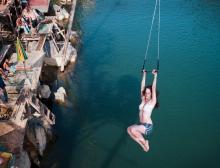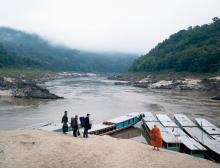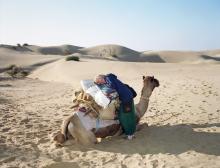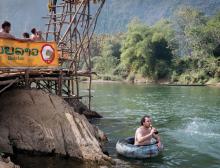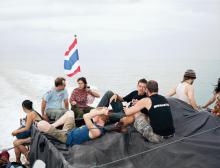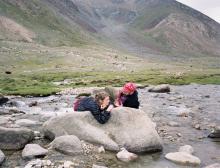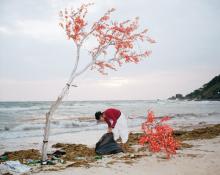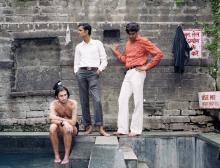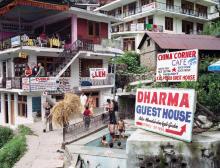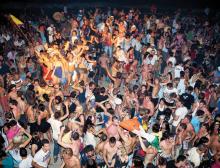Same same but different, the backpack travelers by Jörg Brüggemann
The series “Same same but different” by Jörg Brüggemann portrays young backpacking travelers from western countries, which -from an alternative form of traveling- today represent a new form of mass tourism, with its codes, its recurring traits and its diversity.
It is a topic that particularly interests me, because when I travel I always do backpacking, even though I try as much as possible to leave the beaten circuits. Furthermore I love Jörg Brüggemann color palette and style. Here an interview about his photographs and travels.
Fabiano Busdraghi: How did you start taking pictures? What is your history as a photographer?
Jörg Brüggemann: In 2003 I did an abroad term studying graphic design in Buenos Aires. Back then I visited the typography classes and all of that, but what really thrilled me was wandering around the city and taking pictures. Back in Bremen where I studied at the University of the Arts I took my first serious photography class with professor Peter Bialobrezski. And from then on I took the straight road as I finally found what I really wanted to do.
Fabiano Busdraghi: What is photography for you?
Jörg Brüggemann: Manly a way to tell stories and to confront myself with the world outside of my private life and give a statement about it. But I am a visual person not a writer. Photography just came naturally to me as I ma also not that good at drawing and so on. Apart from that I love to work for my own accounts. Photography gives me a maximum of personal freedom.
Fabiano Busdraghi: How the idea of “Same same but different” was born? Can you describe this work?
Jörg Brüggemann: After the abroad term in Buenos Aires I went traveling around South America for 2 month. That was the first time I got in touch with the backpacking scene. I was fascinated about the dimensions the alternative travel industry had reached. Two years later I had the chance the fly to India and I remembered this idea. I had heard that the backpacking scene in India should be even bigger then the one in South America. It turned out that I underestimated that. But the best or worst was still to come… Thailand.
Fabiano Busdraghi: Backpack travelers often has a distinctive look, that usually is very different from the main style at home. But as you show in you series, at the end everyone looks the same. Do you think that it is just a question of trend but differences exist or there is no hope of personality and individuality?
Jörg Brüggemann: Yes, you are right, fashion is a very strange part of backpacking. I never understood how all these travelers can take off their Levis 501 and put on ridiculous puffy trousers that they will never wear again in their life. Some say they want to dress like the locals. But no locals wear these cloths. It is probably really a question of trend and maybe group pressure. Which also answer the question about personality and individuality.
Fabiano Busdraghi: Backpack traveling was born as an alternative form of tourism. More freedom, less expenses, more contact with the local population. Respect for traditions and environment. Do you think that today backpack travelers has loosed those values? Why the situation has changed?
Jörg Brüggemann: I think these values are still the main reasons why young westerners go backpacking. But do they still find them when they are on the road? Freedom and less expanses, yes. But more contact with local people and respect for traditions and environment, no. The main reason for that are the masses that go backpacking nowadays. You can’t be individual when you are one of millions who go backpacking every year. And the locals have reacted to these masses. They offer the travelers what they want in order to make money. In that way it has become a tourist industry.
Fabiano Busdraghi: Sometimes when you travel it looks as everyone goes in the same youth hostel. You go on the other side of the world just to find yourself in a restaurant where everyone has his lonely planet posed on the table. Do you think that this kind of trip can still be interesting or it would be better to live all the guides home and just travel outside of those circuits?
Jörg Brüggemann: The Lonely Planet can be a helpful tool when you are in country like India. It really makes things easier because it is a thoughtful edited travel guide. The problem is that a lot of people rely too much on it. Some even call it “the bible”. It is really no adventure to travel through Thailand with the Lonely Planet. It is more or less like a packaged tour. So, if you want to see something else leave the Lonely Planet at home. But I prefer to take it with me and then I don’t touch it for weeks or so while traveling. And when I feel like banana pancakes and beautiful beach I look up where the best places are. It just really depends on you what you make out of it.
Fabiano Busdraghi: Yes I understand. I traveled 3 times in South America, the last one without any written guide, and it was a completely different trip.
But let’s go on with the interview: can you choose one of your photos and tell its history?
Jörg Brüggemann: The picture “New Year’s Full Moon Party”.
The Full Moon Party on Ko Pha-Ngan have become legendary. Once a month about 10.000 young traveller gather on Sun Rise Beach in Hat Rin in the South East corner of the island to party all night long. The event is very well organized by the local bar and hotel owners. It is also them that clean up the beach the next day like the woman on the photo. The party crowd has already gone to bed or to one the numerous After Full Moon Party in the village. I took this photo just after sunrise on the 1st of January 2008. In the night a storm had flooded the beach and left not only the rubbish but also a lot of seaweed. The trees were just decoration for the party. Their leafs are made out of paper.
Fabiano Busdraghi: Can you speak about one or more of your favorite photographers and tell us why you love his/their work?
Jörg Brüggemann: Well, it is quiet obvious that Martin Parr has been a big influence, although I claim for myself to be fairer to my subjects. But I simply love his irony and his everyday themes that relate so much more to my own life then most other photographers’ subjects. Same for Joel Sternfeld, Steven Shore and Lars Tunbjörk. My professor Peter Bialobrzeski influenced me as well. His passion for photography and the straight and consequent way in which he works were impressive for me.
And I worked two years in the office of Ostkreuz – Photographers’ agency in Berlin where I learned a lot about editorial photography and about attitude.
I probably admire any photographer whose personality can be seen in his work, because that means that his is passionate about what he does. But it has to be an interesting personality, because otherwise the work will be boring as well.
Fabiano Busdraghi: What are your favorite photography and art sites? Do you read any photo e-zine, blog or online art magazine?
Jörg Brüggemann: Yeah, I am actually quite addicted to photo blogs. There are about 30-40 that I read regularly. I find it very interesting what is going on there at the moment. However I am still not sure if this is not just another bubble because the whole scene is very self referential. I can’t really tell which ones I like the most because they are all very specified. Unfortunately there are very few good ones from Germany.
Fabiano Busdraghi: Do you have any photographic dream? Something you want to shoot and you can’t, some camera you dream to have, some place you want to go…
Jörg Brüggemann: There are a lot of photographic dreams I have, but none that I couldn’t put into reality. It is more the other way around. I need these dreams to make them my next project.
Fabiano Busdraghi: Wonderful answer Jörg! Thank you very much for the interview and good luck making your dreams reality.
